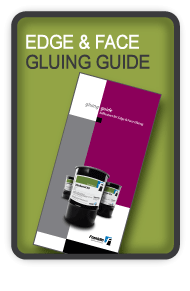Edge and Face
Since the introduction of Titebond Aliphatic Resin wood glue in 1952, Franklin Adhesives & Polymers has been the industry leader in edge and face applications. A decade later, we introduced Multibond cross-linking PVA adhesives, followed by one-part Multibond 2000 and exterior-grade Advantage products. Concerned about meeting formaldehyde regulations or getting LEED points? Recently, we’ve added formaldehyde-free products to the line. These products will not only help you meet these requirements but exceed them.
Our edge and face adhesives are designed for use in radio frequency machines, clamp carriers, presses and clamps. Please see our edge and face gluing and radio frequency edge gluing user guides for additional application and troubleshooting assistance; or contact our technical support team. To determine an appropriate product option for your application, please refer to our product selector.
Edge or face gluing of solid lumber stock can present a unique challenge for adhesives. The adhesive must be rigid enough to withstand the applied stresses found under variable service conditions. Additionally, properly prepared adhesive joints are very important to successful gluing.
To obtain best results in using our adhesives in edge and face applications, please follow the below guidelines.

Spread
Generally, 35-50 pounds of adhesive per 1,000 square feet of glue line is adequate. Conveyorized spreaders are commonly used in this application. The use of a wool felt sleeve on the spreader roll can aid in obtaining a desirable spread and reducing excess glue usage.
Stock preparation
The preparation of the stock to be glued is extremely important. Joints cut from rip saws should be free of saw marks. They should also be straight and square. Moulded or jointed stock should be free of knife marks. Glazed or burnished joints will prevent adhesive penetration and should be guarded against. When possible, glue joints should be prepared and glued the same day.
Moisture content
Six to eight percent is the recommended moisture content for the gluing stock. High moisture content will dramatically increase the clamp time needed. Additionally, panel shrinkage may occur resulting in stress cracks or end-joint delamination.
Pressure
Pressure is dependent upon the species or material to be glued and joint preparation. Direct contact of the gluing surfaces is required to obtain maximum strength. Suggested pressures for various wood densities are: low, 100-150 psi; medium, 125-175 psi; high, 175-250 psi. The use of a compressometer will aid in accurately measuring the amount of pressure being applied to the gluing area.
Minimum temperature
Curing temperatures should be higher than the minimum use temperature of the adhesive. This includes the temperature of the stock to be glued as well as the air and adhesive temperatures.
Clamp time
Clamp time is dependent on the adhesive used, species, moisture content, environmental factors and glue-line thickness. Clamp times can vary from one-half-hour to several hours. Clamp times should be determined under plant conditions.
Additional information on edge and face gluing can be found in the full version of our Edge & Face Gluing Guide or by contacting our technical support team. For more information about gluing equipment, please refer to our resources link.
EDGE AND FACE PRODUCTS:
Advantage 405 & 415 - Highly water-resistant two-part adhesives that surpass both the ASTM D-5572 wet-use finger joint and ASTM D-5751 wet-use edge glue standards.
Assembly High Tack - Excellent for general assembly as well as edge and face gluing of hardwoods and softwoods for interior use.
Multibond 2000 – Produces a water-resistant bond recommended for hot or cold press and assembly gluing applications.
Advantage EP-925 – A highly water-resistant, formaldehyde-free two part adhesive that can be utilized with cold press, hot press or radio frequency press equipment.
Titebond 50 - Fast-setting, heat-resistant adhesive, best used in interior edge and face and assembly gluing.
Titebond Imperial – A high performing, heat-resistant adhesive, best used in interior edge and face gluing.
Titebond Regular – With excellent bond strength, this product is ideal for edge and face gluing and general assembly of a wide variety of wood species for interior use.
Titebond Slow Set - Generally used for lamination of stair rails and stringers, this adhesive was designed for applications that require a long time between glue spreading and clamping for interior use.